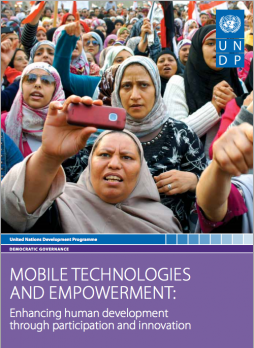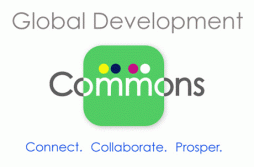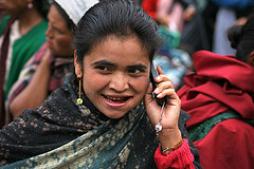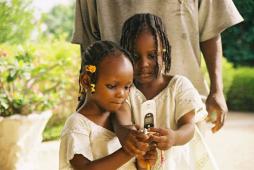development
Posted by Sayama on Mar 12, 2012
Editor's Note: Mairead Heffron is the guest author of this post. She is a former staffer at UNDP on other projects, but reviewed the report in her personal capacity. We appreciate her guest contribution!
A report, recently published by UNDP, on mobile technologies and human development, “Mobile Technologies and Empowerment: Enhancing Human Development through Participation and Innovation”, does a good job of summarizing the many ways in which mobile technologies are being used successfully as tools for stimulating development. It's intended to provide information and ideas for development practitioners on how mobile technologies and applications can be used appropriately and effectively in international development projects. The aim is not to employ technology-based solutions as an end in themselves, but rather as the means to achieving desired development outcomes.
The report begins by examining trends in mobile usage in developing countries. Predictably In Sub-Saharan Africa, only a few countries register 100% or higher penetration (percentage of SIM cards per capita). By the end of 2012, it's estimated that these countries, South Africa, Botswana, and Gabon, will all have mobile penetration rates on a par or slightly higher than that of GermanyFigures for countries on the lower end of the human development index are substantially lower, but still show a massive difference between fixed line subscription penetration and mobile penetration. Witness Mozambique, for example, with 35% mobile penetration, and a dismal 0.3% fixed line penetration (prediction, end of 2011).
Posted by CandiceSimonta-Dyer on Mar 09, 2012
mFisheries data sheet 744 Views
Organization that developed the Tool:
Problem or Need:
The ubiquitous nature of mobile technology has undoubtedly impacted development initiatives across the globe. The Caribbean region in particular has demonstrated high penetration of mobile devices in all facets of society. The integration of mobile devices, adaptive technologies and services into the lives of once marginalized communities thus makes a strong case for outreach and inclusion. The mFisheries initiative focuses its attention on the Caribbean small scale fishing industry, with particular emphasis on Trinidad and Tobago.
mFisheries aims to develop capacity in the Caribbean to pursue opportunities arising from the provision of innovative mobile-enabled services for its poor communities, and to provide related empirical data and analysis to inform Caribbean policy and regulation.
Brief Description:
mFisheries is a suite of mobile applications developed for persons involved in fisheries such as small scale fisher-folk, processors, retailers, wholesalers and consumers.
Although mFisheries was originally designed solely for use on Google's Android operating system, due to widespread regional interest, versions have been developed for all smart phone platforms.
Tool Category:
App resides and runs on a mobile phone
Key Features :
mFisheries has been hard at work at giving access to a wider range of pariticpants through the use of mobile ICT and is proud to present the following open source application versions:
- mFisheries Full - This is a smart phone version built for Android operating systems. This version includes a virtual fisheries market place, daily fish market prices, GPS navigation, a compass, first aid companions, SOS emergency signal and more. This application is designed to work in Trinidad and initiaties at sea tracking once the phone is outside Trinidad's land boundary
- mFisheries Web - This is an online website version built for persons who may prefer to use a computer such as retail stores, wholesalers and consumers. This version includes a virtual fisheries market place, daily fish market prices and more
- mFisheries Mobile Browser - This version is accessible from the mobile web browser of most smart phones. It gives users access to a virtual fisheries market place and daily fish market prices
- mFisheries Blackberry - This version is built specifically for the Blackberry operating system. It will give users access to a virtual fisherier market place and daily fish market prices. This version is available for download in Blackberry App World
Main Services:
Location-Specific Services and GIS
Mobile Social Network/Peer-to-peer
Information Resources/Information Databases
Stand-alone Application
Platforms:
Android
Blackberry/RIM
All phones/Mobile Browser
Organizations Using the Tool:
The University of the West Indies and Fisher-folk associations in Trinidad
Number of Current End Users:
Number of current beneficiaries:
Support Forums:
Facebook
Over the phone support
Bi Monthly Face to Face Meetings
'Help-Desk' application on phone
Handsets/devices supported:
All internet accessible handsets
Reviews/Evaluations:
http://www.guardian.co.tt/business-guardian/2011/11/30/when-agriculture-meets-ict, http://m-survey.org/?p=76, http://sta.uwi.edu/stan/archives/STANapril_july2011.pdf, http://lehigh.academia.edu/CandiceSankarsingh/Papers/340076/Mobile_Opportunities_Exploring_innovative_pathways_for_marginalized_communities, http://www.docstoc.com/docs/100709685/Mobile-Opportunities-Exploring-Innovative-pathways-for-
Is the Tool's Code Available?:
Is an API available to interface with your tool?:
Posted by ccarlon on Jan 27, 2012
Ethnography of the Telephone: Changing Uses of Communication Technology in Village Life data sheet 2329 Views
Author:
Wang, Tricia and Barry Brown
Abstract:
While mobile HCI has encompassed a range of devices and systems, telephone calls on cellphones remain the most prevalent contemporary form of mobile technology use. In this paper we document ethnographic work studying a remote Mexican village’s use of cellphones alongside conventional phones, shared phones and the Internet. While few homes in the village we studied have running water, many children have iPods and the Internet cafe in the closest town is heavily used to access YouTube, Wikipedia, and MSN messenger. Alongside cost, the Internet fits into the communication patterns and daily routines in a way that cell phones do not. We document the variety of communication strategies that balance cost, availability and complexity. Instead of finding that new technologies replace old, we find that different technologies co-exist, with fixed telephones co-existing with instant message, cellphones and shared community phones. The paper concludes by discussing how we can study mobile technology and design for settings defined by cost and infrastructure availability.
Posted by ccarlon on Nov 22, 2011
The Developmental Contribution from Mobile Phones Across the Agricultural Value Chain in Rural Africa data sheet 1362 Views
Author:
Furuholt, Bjorn and Edmund Matotay
Abstract:
The most widespread information and communication technology (ICT) in developing countries today is the mobile phone. The majority of people in the least developed countries still live in rural areas and their livelihood depends on the primary industries. This study investigates the use of mobile phones among farmers in rural Tanzania in order to supply empirical data on the developmental role of this technology. The results show that the improved access to communication and information that mobile phones represent affects the entire cyclic farming life during the year and has resulted in considerable changes in the entire livelihood constructs, increased opportunities and reduced risks for rural farmer.
Posted by VivianOnano on Jun 28, 2011
The Impact Of Mobile Telephony On Developing Country Enterprises: A Palestinian Case Study data sheet 3773 Views
Author:
Rabaya,S. Khalid, Khalid Qalalwi.
Abstract:
This paper aims to explore the use and impact of mobile telephony on the performance of companies in developing countries through a nationwide survey comprised of thousands of enterprises representing a true sample of the business sector in Palestine. This paper complements studies that make the linkage between mobile communications and economic activities at micro or enterprise level. It analyses the adoption patterns and rational behind these patterns as revealed by the business owners and managers of Palestinian enterprises.Porter’s value chain is used as a framework to assess the impact of mobile telephony in work processes.
The survey covered thousands of enterprises of all sizes and economic activities,selected to embody a representative sample of the Palestinian business sector. It further explores the views of the owners and managers of these enterprises regarding the use of ICTs.The study reveals that mobile phones have meaningfully enhanced internal processes and the overall value chain. Most notably, mobile phones were effective in bridging the information and connectivity gap businesses in developing countries ordinarily suffer.
The study has also found that small and micro enterprises gain from the use of mobiles the same as what large enterprises do, especially in mainstream operations like marketing and sales, information flow, and provision of customer services. This is happening at the time when there is a huge difference in resources between the two categories of enterprises. The study came to conclude that mobile benefits are not favoring one business sector from the other, in the sense that all business sectors are capable of tailoring mobile phone services to suit their needs
Posted by MarkWeingarten on Mar 09, 2011
Futures of Technology in Africa data sheet 2245 Views
Abstract:
Technology holds many promises as a driver of positive changes, as a tool to address the problems and as an enabler to fulfil the potential. Economic development requires modern technology and technology plays an important role in most strategies for alleviating hunger and poverty. Technology can reduce transaction costs, save lives, facilitate education, strengthen entrepreneurship, provide access to markets and help to deliver basic services, ranging from water and sanitation to public administration. However, the same technology can also be destructive and a cause of problems. Some technological developments can be facilitated or managed, others happen and require an adequate response.
It is this manifold interrelation of technology with its environment that makes exploring the future of technology so interesting and valuable. There is a need to explore how technology in Africa will or might evolve; to discuss the drivers and the obstacles, the issues technology might resolve and the problems it might cause; to identify how technology changes society and how African societies might change global technology. These are big and complex questions and the STT foresight project, which ends with this publication, is a contribution to this discussion that is still in its infancy with respect to Africa.
Posted by on Jan 01, 1970
n/a
Posted by AnneryanHeatwole on Mar 12, 2010
Mobile Phones and Community Development: A Contact Zone Between Media and Citizenship data sheet 3173 Views
Author:
Gerard Goggin, Jacqueline Clark
Abstract:
Mobile phones have already been used widely around the world for activism, social and economic development, and new cultural and communicative forms. Despite this widespread use of mobile phones, they remain a relatively un-theorised and un-discussed phenomenon in community and citizen's media. This paper considers how mobile phones have been taken up by citizens to create new forms of expression and power. The specific focus is the use of mobile phones in community development, with examples including the Grameenphone, agriculture and markets, the Filipino diasporic community, HIV/AIDS healthcare, and mobile phones in activism and as media. It is argued that mobile phones form a contact zone between traditional concepts of community and citizen media, on the one hand, and emerging movements in citizenship, democracy, governance, and development, on the other hand.
Posted by AnneryanHeatwole on Jan 04, 2010
The new year is kicking off with an assortment of events on the development and techie sides. Here are some of the events that we found to be noteworthy:
Mobile Tech Salon, 20 January, New York: Hosted by MobileActive.org, it's a regular gathering of people passionate about mobile technology for social change. Motto: We bring the beer (and wine)! Bring your projects, passions, tools, and conversation. This month's theme: Mobile Campaigning and Tools on a Shoestring: What is Possible? Advisable?
International CES 7-10 January, Las Vegas, USA: CES is the world's largest technology trade show, attracting more than 2,500 exhibitors and showcasing over 20,000 new products.
Posted by MelissaLoudon on May 27, 2009
At the turn of millennium, tech journalists (clawing their way back from the Y2k=K non-disaster) found smartphones. Futuristic interfaces, newly-discovered mobility and the work-anywhere promise of the Blackberry kicked off the trend, later boosted by the emergence of high-speed mobile Internet and a new crop of Internet-enabled devices. Market figures are for smartphones are certainly impressive, with Gartner recording device sales of 139.4 million in 2008, up 13.9% from 2007.
That same year, the meteoric rise of the iPhone gave us the ability to purchase third-party smartphone applications through the App Store which became a major selling point for the hardware. In the first quarter of 2009, smartphone sales represented 13.5% of mobile phone sales worldwide. Sales show no sign of slowing, and neither does the blistering pace of innovation in hardware, interfaces and 'ecosystems' like the App Store.
Posted by KatrinVerclas on May 07, 2009
Ken Banks has a theory: The long tail theory of mobile applications for social development. It goes something like this, paraphrasing him from his incendiary blog post:
Mobiles are the most rapidly adopted technology in history. But if mobiles truly are as revolutionary and empowering, then don't we have a moral duty in the ICT for Development (ICT4D) community to see that they fulfill that potential?
Banks says that indeed, we do have that moral duty, and I agree with him wholeheartedly there.
Posted by KatrinVerclas on Oct 13, 2008
Reposted from MobileActive08.org, by Brett Davidson
This afternoon I attended 'The Mobile Web': The potential and reality for developing countries, facilitated by Toni Eliasz.
There was extended discussion of the value of the mobile web to developing countries. Views hinge a lot on how one defines 'mobile web'. Some people had strong reservations about the potential of the mobile web, related to affordability, the need for high-end phones in order to browse the internet, the high cost of data access via cellphone networks, and ongoing problems with connectivity.
But many of these reservations can be removed if one defines the mobile web more broadly than accessing the Internet. One person proposed defining it as access to data and databases in whatever form. So if people are able to access data on the Internet, through tailored SMS services, for example, that qualifies as the mobile web.
Posted by KatrinVerclas on Oct 09, 2008
There is yet another competition focused on mobile app development, this time sponsored by USAID and Netsquared. Starting on October 13, Development 2.0 will reward the innovative uses of mobile technologies for international development withup to $10,000 for the winner. While this is less than some of the other recent competitions, applicants can get advice and improve their ideas and clarify their project submissions during the entire application process on a project gallery.
A open voting process will determine the best projects, and then a jury of USAID senior staff will select the final winners. More info is here.
Other compeitions open right now:
Knight News Challenge -- $5 million awarded to digital media projects, including mobile citizen media projects;
Posted by KatrinVerclas on Oct 09, 2008
Brough Turner is a renowned telcom industry professional with a passion for mobile and a very smart guy. We recently interviewed him about the mobile web for a paper on cell phones in citizen media. What he said is useful for thinking about this in the context for social benefit, so we post it here for you, before the release of our report. We will also have a workshop on the role of the mobile web for social development at MobileActive08.
You asked me to elaborate on today's mobile web and how it will change with the advent of 3G networks. Here we go: Mobile phone networks provide the best telephony coverage in the world and, for more than a decade, mobile operators have had a "data" story. Unfortunately, the data side of mobile telephony has been slow, expensive and limited in what it can access.
Posted by KatrinVerclas on May 20, 2008
Danny Quah is Head of Department and Professor of Economics at the London School of Economics. I had the pleasure of meeting Danny at the recent release of "Wireless for Social Change: Trends in NGO Mobile Use," in London. This report is an exploration of how mobile technology is changing the way NGOs do their work, and includes case studies of how mobiles are used in social development. Danny had an articulate and cogent critique of our findings. We thought it would be interesting to MobileActive readers to hear his thoughts -- with which I could not agree more -- re-published here with permission.
Posted by CorinneRamey on Apr 02, 2008
In 2005, Samsung released a phone designed especially for women. The phone, with a "curvaceous, feminine design" included applications like a fragrance and aromatherapy guide, a shopping list, a calorie counter, a biorhythm clock, and a calendar to help women keep track of their periods. "Almost every woman will desire it," wrote one reviewer, in a piece entitled "High tech for the ladies."
Those marketers and reviewers have it all wrong.
For women around the world, mobile phones are not about sexy designs and knowing when it's that time of the month. Mobile phones are slowly changing the lives of women who use them and the communities in which they live. They've created a path out of poverty for many women in the developing world, as microfinance and "phone ladies" running businesses increase in numbers. Mobiles are enabling translation for victims of domestic violence in the United States, provide Ukrainian sex workers a way to safety, and protect Philippine domestic workers in the Middle East. Mobile phones are giving voice to female reporters in Africa and encouraging free speech in Egypt. And as mobile phones become increasingly ubiquitous -- they're already at 3.3 billion and counting -- they are likely to continue to influence the lives and societies of the women who use them in the future.
Posted by CorinneRamey on Feb 26, 2008
MobileActive has aggregated dozens of videos focused on the use of mobile phones in civil society on our new MobileActive YouTube channel.
The MobileActive channel features playlists about mobile phones used in a variety of different fields. On the Mobile Phones in Advocacy playlist, you can watch videos about Greenpeace Argentina's work to pass the Ley de Bosques (Forest Law) by using mobile phones and an advertisement for FishMS, a South African SMS infoline that allows users to text in the names of fish and get a rating about their environmental sustainability. Watch the Mobile Phones in Global Development channel for videos on mobile banking, the Village Phone program, and the growth of mobile phones in the developing world. Check out the Mobile Phones in Human Rights playlist for a variety of videos of human rights abuses taken on mobile phones, including the mobile videos of Egyptian police brutality by blogger Wael Abbas.
Other MobileActive YouTube playlists include Mobile Phones in Citizen Media, Mobile Phones in Disasters and Relief, Mobile Phones in Education and Learning, Mobile Phones in Elections and Participation, Mobile Phones in Poverty Alleviation, and many others.
Check out the new MobileActive YouTube channel and add your videos on the mobile revolution!
Posted by CorinneRamey on Feb 08, 2008
With mobile phones become ubiquitous in developing countries and emerging markets, phone manufacturers istening to the unique design needs of users there. Younghee Jung , an anthropologist working for Nokia, spoke about the design possibilities for improving phones for the developing world at the LIFT conference in Geneva, Switzerland that addresses the "challenges and opportunities of technology in society."
In a video presentation, Younghee speaks about the research that Nokia conducted in shantytowns in three cities: Mumbia, India, Rio de Janeiro, Brazil and Accra, Ghana. The team conducted ethnographic research, conducted street surveys, and sponsored an "open studio" contest in which they asked people to design their ideal mobile phone.
Posted by CorinneRamey on Sep 28, 2007
The rural mobile market is growing, and carriers are working to meet the unique demands and challenges of this sector of the population. Even in the poorest countries -- like Sierra Leone, which ranks 176 out of 177 countries on the UN's 2006 Human Development Index -- mobile phones have become a growing necessity, creating a unique set of cultural norms and practices. According to a recent article in Africa News, "It is no secret that Sierra Leone has one of the largest mobile network services although said to be the least developed country in the West African Sub-Region." Mobile service in Sierra Leone is covered by three carriers -- Mobitel, Celtel and Millicom. Although the network has increased dramatically since the civil war ended in 2000, there is still demand from rural customers for more comprehensive coverage in poor rural areas.
Posted by CorinneRamey on Sep 28, 2007
Mobile use and prevalence is exploding throughout the developing world. As Tim Kelly writes in id21 insights's September newsletter, in 1990 there were only 14,200 mobiles in Africa, which by, 2005, grew to a total of 137 million. Id21 predicts that the majority of the world's poor will have mobile access within the next generation. This number continues to increase, showing just how important mobile phones have become in development.
In our ongoing series on mobiles in development -- m4dev, as we are calling it, we are pleased to see that id21 focuses its current newsletter on mobiles used in development, with articles profiling mobiles used in countries including Nigeria, Bangladesh, Jamaica, and Zambia.
Posted by on Jan 01, 1970
n/a







